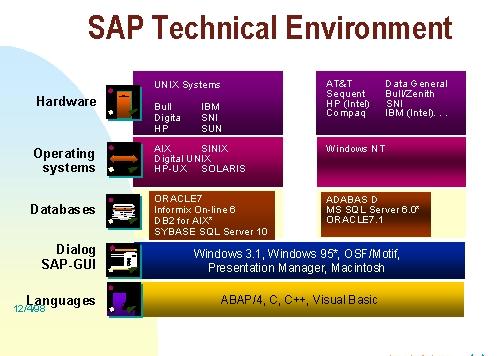Open
Technology
The key to
SAP R/3 success was the strategy of making open solutions, in which the
applications can run on multiple operating systems, databases, and communication
technologies. This enables customers to remain independent of single vendor
if they wish.
The figure
shows all current SAP supported systems. For an update of supported systems,
contact SAP or ask any system vendor.
What basically
makes system open is the use of standard formats for data exchange,
communication interfaces, and program - to - program communication. SAP
extends the openness concept in several
respects:

-
At the system level.
Support for multiple operating systems platforms such as Unix, WindowsNT
and AS/400. Supports large number of standard GUIs (User interfaces) such
as Windows 3.1, Windows 95, Windows NT, Macintosh, Motif and OS/2 Presentation
Manager.
-
At the database level.
R/3 supports various relational database systems such as Oracle, Informix,
Adabas D, DB2, and SQL-Server. Access to the data managed by R/3 is possible
using standard R/3 reports as well as any other SQL standard tool:
ODBC, SQL browsers, and so on. SAP has incorporated the standard ANSI-SQL
as the database manipulation language, which allows users and programmers
to store, view, and retrieve data to and from all different underlaying
database products.
-
At the application level.
The system is open to be enhanced and extends to meet specific business
requirements. The ABAP/4 repository and R/3 reference model enables users
to understand the relationships and inner working of R/3 applications
The R/3 programming interface lets other R/3 systems and external programs
invoke R/3 function modules via RFCs (Remote Function Calls). SAP offers
the RFC SDK, a standard interface for customers and independent software
venders to carry out individual extensions to SAP business applications
that support the direct communication with the function modules of R/3.
-
At the desktop level.
With the development of microsoft OLE technology, R/3 enables desktop users
to access SAP data and functions many OLE client programs.
-
At Communication protocol
level. SAP
can use the standard communication protocols TCP/IP, SNA-LU6.2, CPIC and
OSF/DCE/DME for inter program communications as well as for network communication
and data transfer.
At External Communication
level.
-
R/3 includes EDI (Electronic data interchange) interfaces to automate the
exchange of data (invoices, orders, etc.,) between R/3 and other applications
systems used by business partners.
-
It also uses MAPI technology, supporting standard x.400 and SMTP protocols.
These standards allow R/3 users to communicate with other mail systems
and Internet.
-
With ALE technology , SAP R/3 allows communication between distributed
applications: R/3-R/3 systems, R/3-R/2 systems, R/3 external application
systems.
-
Using development environments such as standard ANSI C, C++, Visual Basic,
developers can integrate external applications with the R/3 system, exchanging
information on the level of business objects.
